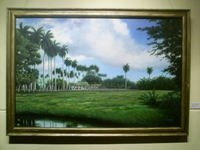Cuban Identity Depicted in Camagüey-born Painter’s Own Academy

But as he well specified, Requejo's Paiting Academy is a sort of foray in the different thematic lines that rule professional painting studies. On the one hand, the purpose was to create his own academy, and on the other hand, to transmit many of the motives that allow him to recreate his taste for pictorial motifs: local customs and manners, native features, faces and human figures, and the coherent mix of them all.
That is why we can see still lifes, landscapes, and portraits in the 12 paintings that make up the exhibit, carried out with traditional techniques like the use of chiaroscuros and sepia, and others more contemporary in a bid to overstep reality and go beyond reason.
A leit motif in some of his works is the royal palm (symbol of the nobility and steadfastness of Cubans), which has a considerable role in each picture within the set of elements that make it up. Is it perhaps some kind of “Requejo identification” or a way to reflect your taste for the vernacular?
I love palm trees and besides, I believe it is one of the elements that provide my works with Cuban identity; in fact, it is hard to visualize a Cuban landscape without royal palms. For instance, Finca El Porvenir (one of the paintings’ title) is a real place in Redención, located in the municipality of Minas (some 36 km north-east of Camagüey), where my grandmother lived for so long and my mother and her brothers grew up.
In the painting we can see the cattle-handling facility, creek and cluster of palms surrounding the farmhouse, a landscape repeated all over the country. However, I must confess it was quite difficult to get a perspective that included the whole set. This painting has a quite interesting anecdote.
Would you like to share it?
Everyone told me it would be very difficult to get a picture of the whole environment, but that was what I wanted, or rather what my grandmother wanted. She always said this landscape was ideal for a painting and that someone in the family had to be the artist.
One day, I went there and after trying countless times, I decided to cross the creek with the camera on my back since that seemed to be the only possible way and luckily it was, for I was already running out of ways out.
I insist on your interest for the properly Cuban features shown in this exhibit. The contrast between the two still lifes invites attention. A traditional one: fish, glasses of wine, fruit … The other, purely Creole: roast pork on yagua leafs, cassava bread, beer mugs and a pot with congri (Cuban style rice with beans), by the side of a hat made of yarey, two machetes and a stool …
Precisely, I intend to reflect this opposition, I mean, from a world trend that does not go out of fashion, like the still lifes, I try to depict the Cuban identity.
However, there are other two paintings: a seascape with two dolphins, and a bullfighter, which are not related to the Cuban culture as such.
Because this exhibit’s main goal is to paint everything that inspired me to create my own academy and, in the long run, that I wanted to mix up and thus achieve new surrealistic creations. For example, I have other two paintings – not on display, although they are indeed part of the project – that reflect this trend. One of them blends human figure and landscaping: I draw off a waterfall out of a naked woman’s hair, in the foreground, which is part of the background landscape.
Precisely Energía natural (Natural Energy), Divinidades (Deities) and Autorretrato (Self-portrait) are examples of surrealism. Will this be the line Requejo will choose to follow?
That’s what I have in mind.
After all, where does architecture fit in?
I graduated as an architect two years ago and I am about to finish my job training. Although it is not in my plans to quit this profession I also like a lot, I expect to devote more time to painting from now on.
Once the exhibit at the Fidelio Ponce de León Gallery (in the Office of the City Historian of Camagüey) is done, Requejo's Paiting Academy will move to an exhibition space in La Comarca Literary Café, on the ground floor of the Hermanos Saíz Association’s provincial venue. (Radio Cadena Agramonte ).

